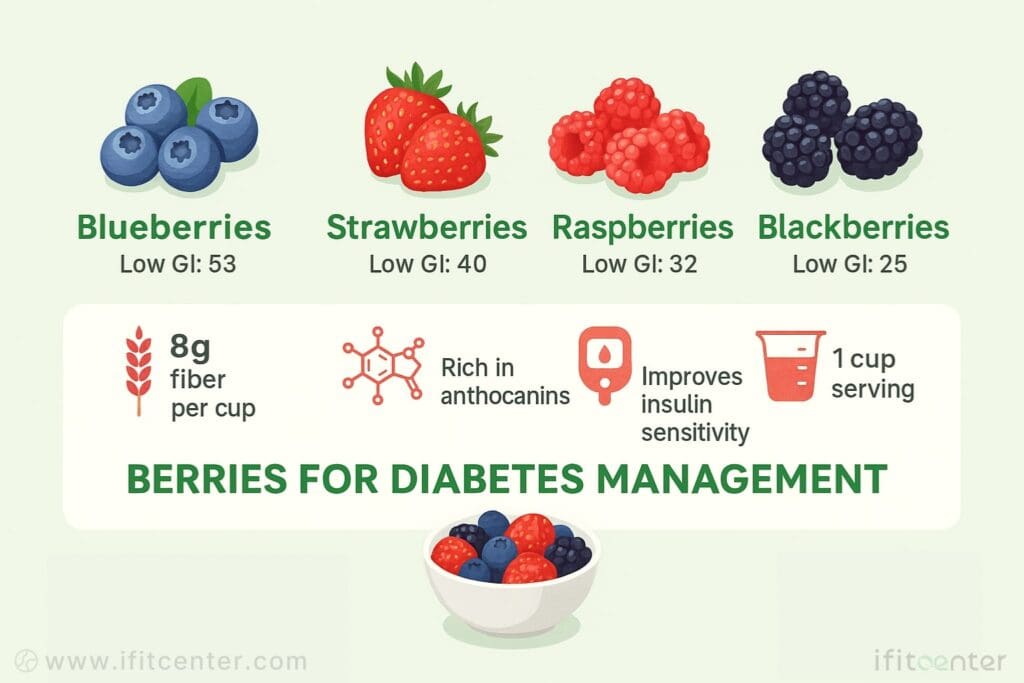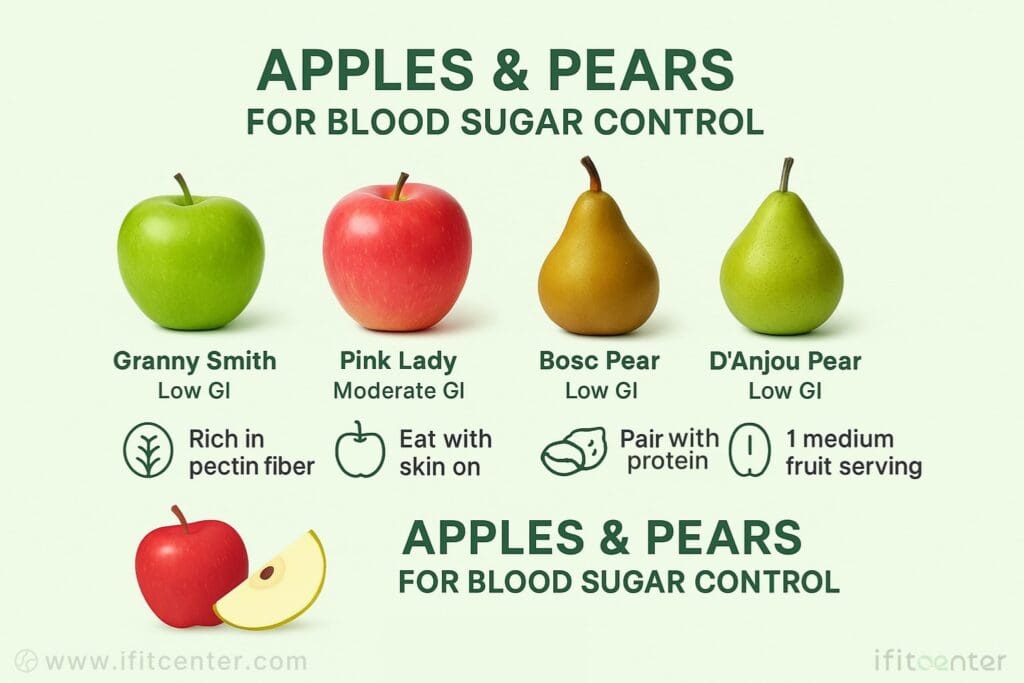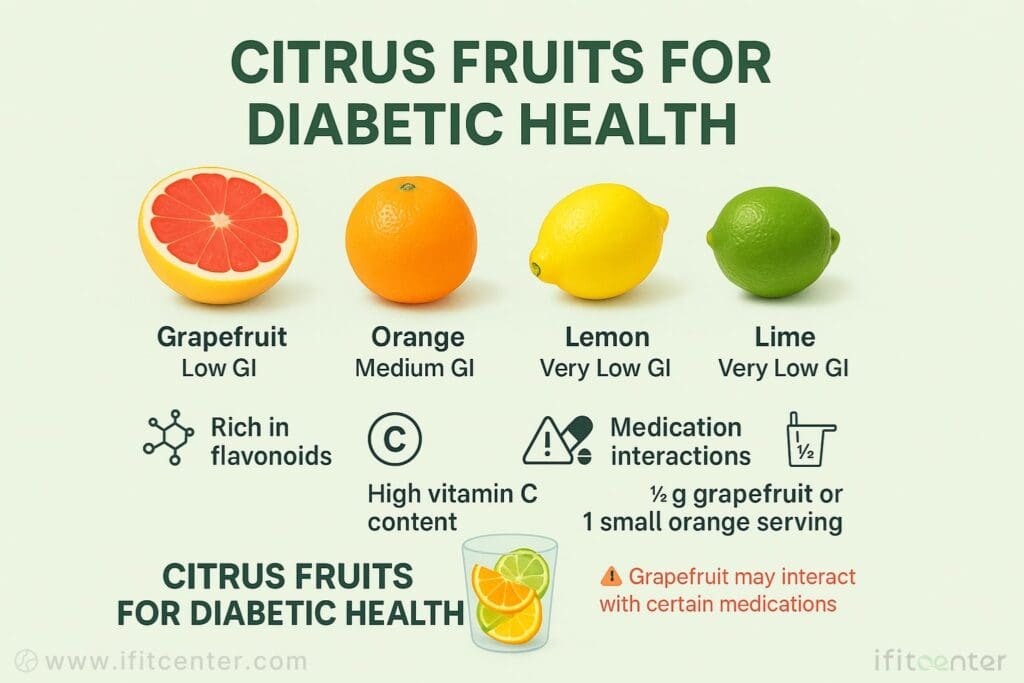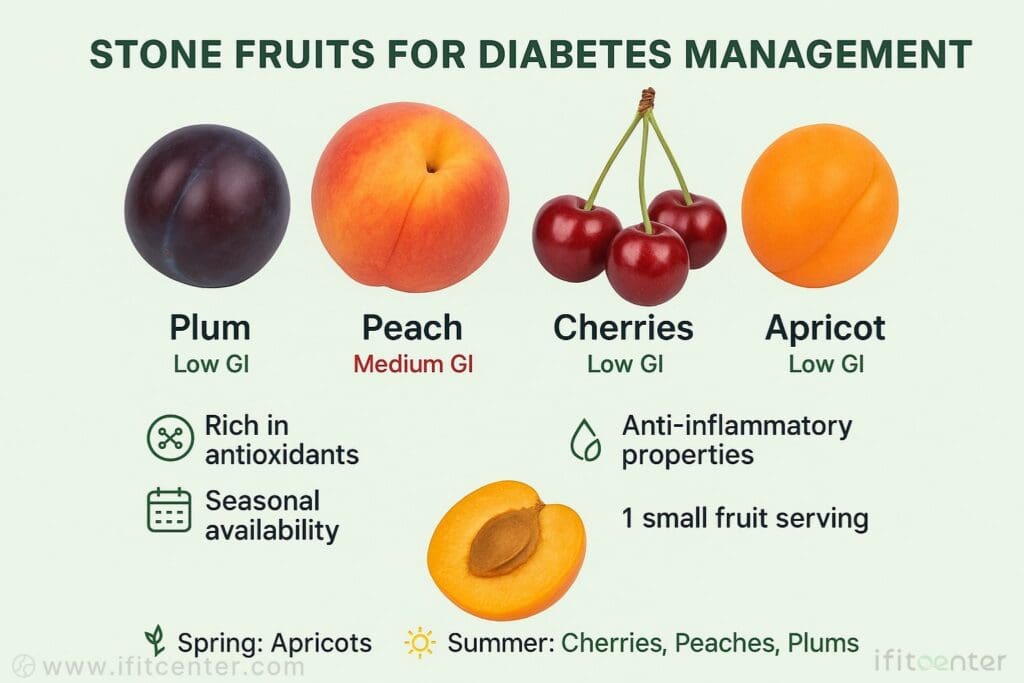Are you living with diabetes and wondering which fruits are actually safe to eat? Have you been avoiding fruit entirely because you’ve been told it will spike your blood sugar? When searching for the best fruits for diabetics, patients often face contradictory advice that leaves them confused and frustrated. The reality might surprise you: not only can diabetics enjoy certain fruits, but some fruits may actually help manage blood sugar levels.
The common belief that people with diabetes must avoid all fruits is outdated and unsupported by current research. This misconception stems from oversimplifying the relationship between fruit sugar and blood glucose. At IFitCenter, we’ll thoroughly examine which fruits can be beneficial for diabetic patients and how to incorporate them into a balanced diet plan.
Understanding which fruits to choose and how to consume them can transform your diabetes management approach. This comprehensive guide will help you navigate the complex relationship between fruit consumption and blood sugar control, providing you with practical, evidence-based recommendations you can implement immediately.
Berries: Optimal Choices for Blood Sugar Control

Among the best fruits for diabetics, berries consistently rank highest in scientific research. Their combination of low sugar content and high beneficial compounds makes them particularly valuable for blood sugar management.
“While many diabetic patients avoid fruits entirely due to sugar concerns, research consistently shows that berries actually improve insulin sensitivity rather than worsen it. In my clinical experience, the patients who incorporate measured portions of berries regularly show better glycemic stability than those who eliminate all fruits. The key is understanding that the anthocyanins in berries actively support glucose metabolism—they’re not just ‘less bad’ than other fruits, they’re actively beneficial.”
Dr. Babak Jamalian, Family Physician.
Types of Beneficial Berries
- Blueberries: Rich in anthocyanins that improve insulin sensitivity
- Strawberries: High in vitamin C and fiber while being naturally low in sugar
- Blackberries: Contain 8 grams of fiber per cup, helping slow sugar absorption
- Raspberries: Offer one of the highest fiber-to-sugar ratios of any fruit
Research on Berries and Diabetes
A systematic review published in the BMJ journal showed that consumption of blueberries and other types of berries is associated with a significant reduction in the risk of type 2 diabetes. In another study published in the Journal of Nutrition, participants with insulin resistance who consumed blueberries daily for six weeks showed significant improvements in insulin sensitivity compared to those taking a placebo.
In our IFitCenter blog, we have provided you with a completely free database about various diseases, which knowing about them will be very helpful in the prevention and control of diseases, especially diabetes. To access the first part of the materials related to diabetes, I recommend using the links below:
- what is diabetes?
- what is type 1 diabetes?
- what is type 2 diabetes?
- diabetes symptoms
- diabetes diagnosis criteria
Why Berries Benefit Blood Sugar Control
- Anthocyanins: These compounds improve insulin sensitivity, helping cells better respond to insulin
- Fiber content: Soluble fiber slows digestion and sugar absorption, preventing sharp blood glucose spikes
- Low glycemic load: Despite their sweet taste, berries contain relatively little sugar and their fiber further reduces blood sugar impact
- Anti-inflammatory effects: Antioxidants in berries reduce inflammation, potentially improving glucose processing
Glycemic Impact of Different Berries
| Berry Type | Approximate GI | Fiber per Cup | Net Carbs per Cup |
| Strawberries | 40 | 3g | 8g |
| Blueberries | 53 | 4g | 17g |
| Blackberries | 25 | 8g | 7g |
| Raspberries | 32 | 8g | 7g |
Recommended Portions and Consumption
- Standard portion: ¾ to 1 cup of fresh berries (75-150g)
- Frequency: Daily consumption offers the greatest benefits
- Timing: Most beneficial with breakfast or as a mid-afternoon snack
- Form: Both fresh and frozen berries (without added sugar) provide similar benefits
Practical Ways to Include Berries
- Pair with protein or healthy fats (Greek yogurt, nuts, nut butter) to further slow glucose absorption
- Add to oatmeal, unsweetened yogurt, or low-carb breakfast options
- Blend into smoothies with non-starchy vegetables and protein
- Freeze berries for a refreshing snack that helps with portion control
- Add to green salads for natural sweetness without dressing
Apples and Pears: Fiber-Rich Options for Diabetics

Apples and pears rank among the best fruits for diabetic patients due to their unique fiber composition and beneficial effects on blood sugar control. Research consistently shows these everyday fruits can play a valuable role in diabetes management.
Research on Apples, Pears and Blood Sugar
A study published in the BMJ journal in 2013 showed that consumption of specific fruits, including apples and pears, may be associated with a reduced risk of type 2 diabetes.The AusDiab cohort study further confirmed that apple consumption had particularly strong associations with improved glucose metabolism parameters among commonly consumed fruits.
The Special Fiber Profile
The secret to these benefits lies in the specific type of fiber these fruits contain:
- Pectin: A soluble fiber that forms a gel-like substance in your digestive tract, slowing down sugar absorption and preventing blood glucose spikes
- Polyphenols: Particularly quercetin, which may help reduce intestinal absorption of glucose and improve insulin sensitivity
- Balanced fructose: The natural sugars in apples and pears are buffered by their fiber content, resulting in a more gradual blood sugar response
Best Varieties for Diabetic Patients
When selecting apples and pears, opt for:
- Granny Smith apples: Lower sugar content and higher fiber than most varieties
- Pink Lady apples: Good balance of sweetness and acidity with moderate glycemic impact
- Bosc pears: Higher fiber content with a slightly grainy texture that signals more beneficial fiber
- D’Anjou pears: Lower on the glycemic index than sweeter varieties
Optimal Consumption Methods
- Keep the skin: The skin contains a significant portion of the fiber and beneficial polyphenols (just wash thoroughly)
- Eat whole rather than juiced: Juicing removes the fiber that moderates blood sugar impact
- Slightly underripe: Fruits with slight firmness typically have a lower glycemic impact than very ripe, soft fruits
- Portion control: One medium apple or pear (about 150g) provides benefits without excessive carbohydrates
Practical Serving Suggestions
- Pair with a tablespoon of nut butter for protein and healthy fats to further stabilize blood sugar
- Add thin slices to a mixed green salad with walnuts for a balanced meal
- Enjoy a small apple or half a pear as a mid-afternoon snack to help manage hunger and energy levels
- Sprinkle with cinnamon, which has been shown to help improve insulin sensitivity
For optimal blood sugar management, consume apples or pears about 30 minutes before exercise or as part of a balanced meal rather than on an empty stomach. This timing helps minimize any blood sugar impact while providing sustained energy.
Citrus Fruits: Vitamin C and Flavonoids for Diabetic Health

Citrus fruits are among the fruits good for diabetics due to their unique nutritional profile and beneficial compounds. Research shows that certain citrus options can support healthy blood sugar levels when included appropriately in a diabetic diet.
Beneficial Citrus Options for Diabetes
- Grapefruit: Contains naringenin, which has been linked to improved insulin sensitivity
- Oranges: Rich in soluble fiber and antioxidants with a moderate glycemic impact
- Lemons and Limes: Very low in sugar and high in vitamin C, making them excellent additions for flavoring
- Tangerines: Contain compounds that may help regulate blood lipids and glucose
In this section, we invite you, dear readers, to study the second part of the materials, which is related to diabetes, in the IFitCenter blog through the links below:
- can you be cured from diabetes?
- what is normal hba1c by age
- Genetic connection to diabetes
- superfoods for diabetes
Research on Citrus and Diabetes
Studies published in medical journals have shown that grapefruit consumption is associated with reduced risk of type 2 diabetes. The beneficial effects appear to come from specific flavonoids like naringenin and hesperidin, which may improve insulin sensitivity and reduce inflammation.
Research indicates that the soluble fiber in oranges, called pectin, helps moderate blood sugar absorption. Additionally, the high vitamin C content of citrus fruits supports overall immune health, which is particularly important for diabetic patients who may have compromised immunity.
Glycemic Impact Considerations
| Citrus Fruit | Glycemic Index | Sugar Content | Fiber Content |
|---|---|---|---|
| Grapefruit | Low | Low | Moderate |
| Orange | Medium | Moderate | High |
| Lemon/Lime | Very Low | Very Low | Low |
| Tangerine | Medium | Moderate | Moderate |
Whole citrus fruits have significantly lower blood sugar impacts than their juiced counterparts due to the intact fiber. This fiber slows sugar absorption and helps prevent blood glucose spikes.
Important Medication Interactions
Caution: Grapefruit and certain medications don’t mix well. Compounds in grapefruit can interfere with enzymes that metabolize many medications, including:
- Some statins (cholesterol medications)
- Certain blood pressure medications
- Some anti-anxiety medicines
- Specific immunosuppressants
If you take any medications, consult your healthcare provider before regularly consuming grapefruit or its juice. This interaction doesn’t apply to other citrus fruits like oranges, lemons, or limes.
Ideal Consumption for Diabetics
- Portion size: Half a medium grapefruit, one small orange, or one small tangerine
- Frequency: 2-3 times per week as part of your overall fruit intake
- Best forms: Whole fruit with membrane and pulp intact (avoid juices)
- Timing: Best consumed as part of a balanced meal rather than alone
Practical Consumption Tips
- Add lemon or lime juice to water instead of sugary drinks
- Include half a grapefruit with breakfast alongside protein
- Add orange segments to salads for natural sweetness
- Use citrus zest to flavor dishes without adding carbohydrates
- Try a small orange as a pre-workout snack for sustained energy
When choosing citrus fruits, select those that feel heavy for their size, indicating juiciness. Store at room temperature if you’ll consume them within a week, or refrigerate for longer freshness.
Stone Fruits: Underrated Diabetes-Friendly Options

Stone fruits – named for their hard, stone-like pits – are often overlooked as fruits suitable for diabetics. These seasonal treats offer moderate glycemic impact while providing valuable nutrients and beneficial compounds that support blood sugar regulation.
Beneficial Stone Fruits for Diabetic Patients
- Cherries: Rich in anthocyanins that may help reduce inflammation and improve insulin sensitivity
- Plums: Contain fiber and specific phenolic compounds that may benefit blood sugar control
- Peaches: Provide fiber, vitamins, and carotenoids with moderate sugar content
- Nectarines: Similar to peaches but with smooth skin, offering beneficial nutrients with modest glycemic impact
- Apricots: Low glycemic impact with beta-carotene and fiber that support overall health
Research on Stone Fruits and Diabetes
Research suggests that compounds in stone fruits may help with glucose regulation. Studies show that cherries contain anthocyanins similar to those found in berries, which may help improve insulin sensitivity. The phenolic compounds in plums have been studied for their potential to slow carbohydrate digestion and absorption.
Stone fruits generally showed neutral effects in diabetes risk studies – neither increasing nor decreasing risk significantly – making them safe options when consumed in appropriate portions.
Glycemic Impact and Nutritional Benefits
| Stone Fruit | Glycemic Impact | Key Nutrients |
|---|---|---|
| Cherries | Low | Anthocyanins, vitamin C, potassium |
| Plums | Low-Medium | Fiber, vitamin K, antioxidants |
| Peaches | Medium | Vitamin A, vitamin C, potassium |
| Nectarines | Medium | Vitamin A, vitamin C, potassium |
| Apricots | Low | Beta-carotene, fiber, vitamin E |
Stone fruits provide beneficial compounds while having a relatively modest impact on blood sugar when eaten in appropriate portions. Their fiber content helps slow sugar absorption, while their water content contributes to hydration.
Seasonal Availability
- Late Spring: Apricots, early cherries
- Summer: Cherries, peaches, nectarines, plums
- Late Summer/Early Fall: Late-season plums, some peach varieties
The limited seasonal availability of stone fruits helps naturally moderate consumption. Fresh stone fruits are typically available from May through September in most regions, with specific timing varying by location and climate.
Serving Suggestions and Consumption Strategies
- Portion size: One small fruit or half a large fruit (about 100g) per serving
- Frequency: 2-3 times per week during season as part of your overall fruit intake
- Ripeness: Slightly firm fruits typically have lower sugar content than very ripe ones
- Pairing: Combine with protein (like a small handful of almonds) to further moderate blood sugar impact
Practical Ways to Enjoy Stone Fruits
- Add sliced peaches to plain yogurt with cinnamon
- Include cherries in a mixed fruit bowl with berries
- Grill peach halves and serve with a small dollop of cream
- Freeze pitted cherries for a refreshing summer treat
- Add chopped fresh apricots to overnight oats
For year-round options, look for frozen stone fruits without added sugar. Avoid canned varieties packed in syrup, which add unnecessary sugars. If using canned fruits, choose options packed in water or their own juice, and drain well before eating.
Other Beneficial Fruits for Diabetics: Beyond the Common Options
Beyond berries, apples, and citrus fruits, several other fruits good for diabetics deserve attention. These options offer unique benefits while maintaining a favorable glycemic profile, making them valuable additions to a diabetes-friendly diet.
Avocados: The Low-Carb Fruit for Diabetic Patients
Though often mistaken for a vegetable, avocado is technically a fruit that stands out as one of the best fruits for diabetics. Unlike most fruits, avocados are rich in healthy monounsaturated fats rather than carbohydrates.
- Blood sugar impact: Minimal, with very low carbohydrate content
- Benefits: Healthy fats that improve insulin sensitivity, fiber that supports digestive health, potassium that helps regulate blood pressure
- Additional advantage: The healthy fats in avocados can help slow the absorption of other carbohydrates when eaten together
Kiwi, Guava, and Other Low-Glycemic Options
Several lesser-discussed fruits offer significant benefits for diabetic persons while maintaining favorable glycemic profiles:
- Kiwi: High vitamin C content, good fiber levels, and moderate glycemic impact despite their sweet taste
- Guava: Exceptionally high in fiber, particularly in the edible seeds and skin, helping moderate blood sugar response
- Pomegranate: Contains unique antioxidants that may help reduce insulin resistance
- Star fruit: Low in carbohydrates with high vitamin C and fiber (caution: not recommended for those with kidney problems)
- Dragon fruit: Low in sugar with beneficial fiber and antioxidants
Research Supporting These Fruits for Diabetes
Studies have shown that avocados may help improve insulin sensitivity due to their healthy fat content. A diet that includes moderate amounts of monounsaturated fats, like those found in avocados, has been associated with better glycemic control in people with type 2 diabetes.
Research on kiwi suggests it may help manage blood sugar levels due to its unique fiber composition. Similarly, the high fiber content in guava has been linked to improved glycemic responses. These fruits have generally shown neutral or positive effects in studies examining fruit consumption and diabetes risk.
Recommended Portions for Diabetic Patients
| Fruit | Recommended Portion | Carbohydrate Impact |
|---|---|---|
| Avocado | ¼ to ½ medium | Very Low |
| Kiwi | 1 medium | Low-Moderate |
| Guava | 1 small | Low |
| Pomegranate | ¼ cup seeds | Moderate |
| Dragon fruit | ½ cup cubed | Low |
As with all fruits, portion control remains essential for diabetic patients. The lower carbohydrate content of these fruits allows for easier integration into a diabetes management plan when consumed in appropriate amounts.
Creative Ways to Enjoy These Healthy Fruits for Diabetics
- Avocado:
- Mash and spread on whole-grain toast as a breakfast option
- Slice and add to salads for creamy texture without dressing
- Blend into smoothies for added creaminess without dairy
- Kiwi:
- Slice and add to plain yogurt with a sprinkle of cinnamon
- Mix into a berry salad for added tartness
- Enjoy half a kiwi before a workout for sustainable energy
- Guava:
- Slice with a sprinkle of chili powder (traditional in many cultures)
- Add to cottage cheese for a protein-rich snack
- Use as a natural sweetener in herbal teas
For optimal blood sugar management, pair these fruits with sources of protein or healthy fats. For example, enjoy kiwi with a small handful of nuts, or add pomegranate seeds to a salad with chicken or fish. This pairing helps further moderate any glycemic impact while creating more satisfying meals and snacks.
Practical Guidelines for Fruit Consumption with Diabetes
Knowing which fruits are good for diabetic patients is just the first step. How and when you consume these fruits significantly affects their impact on blood sugar. These practical guidelines will help you maximize the benefits of fruit while minimizing potential blood glucose spikes.
Enhance Your Diabetes Management at IFitCenter
Choosing the right foods, like diabetes-friendly fruits, is just one part of effective blood sugar management. At IFitCenter, under the guidance of Dr. Babak Jamalian, our specialized weight-loss programs enhance your overall diabetes care. Our targeted services include:
✔ Customized nutritional counseling tailored for diabetics
✔ Expert-led weight loss strategies for optimal glucose control
✔ Continuous professional monitoring for safe progress
Boost your health journey with personalized support today.
Optimal Timing for Fruit Consumption
The timing of when diabetics can eat fruits matters significantly:
- Morning consumption: Many diabetic patients tolerate fruit better earlier in the day when insulin sensitivity is naturally higher
- With meals rather than alone: Consuming fruit as part of a balanced meal slows sugar absorption compared to eating fruit on an empty stomach
- Pre-exercise timing: Having a small serving of fruit 15-30 minutes before physical activity allows your body to use the natural sugars as immediate energy
- Avoid bedtime consumption: Many people experience reduced insulin sensitivity at night, making evening the least optimal time for fruit
“One of the most overlooked aspects of fruit consumption for diabetic patients is timing. Morning consumption typically produces a significantly different glucose response than evening consumption of the exact same fruit in the same portion. This is due to natural circadian variations in insulin sensitivity. I advise patients to conduct their own simple experiment: check blood glucose after eating the same fruit in the morning versus evening, and they’ll often discover a dramatic difference that can guide their personal fruit consumption schedule.”
Dr. Babak Jamalian, Family Physician.
Food Pairing Strategies for Diabetic Patients
Strategic food combinations can significantly reduce blood sugar impact:
- Protein pairings: Combine fruit with protein sources like Greek yogurt, cottage cheese, or a hard-boiled egg
- Healthy fat combinations: Pair fruit with nuts, seeds, or nut butters (e.g., apple with almond butter)
- Fiber enhancement: Add extra fiber by combining fruit with chia seeds, flaxseeds, or unsweetened bran cereal
- Cinnamon addition: Sprinkle cinnamon on fruit, as it may help improve insulin sensitivity
These pairings create a “buffering effect” that slows carbohydrate absorption and prevents rapid blood sugar spikes.
Portion Control for Best Fruits for Diabetics
Proper portion size is crucial when determining what fruits are good for diabetics to include regularly:
- Small fruit: One small whole fruit (about the size of a tennis ball)
- Berries: ¾ to 1 cup
- Melon and larger fruits: 1 cup cubed or 1 slice (about 1 inch thick)
- Dried fruit: Maximum 2 tablespoons (dramatically reduce portion due to concentrated sugars)
Visual references help with portion control:
- A serving of berries should fit in a cupped palm
- A medium apple or orange is roughly the size of a baseball
- A serving of cut fruit should fit in a standard measuring cup
- A portion of avocado (1/4 to 1/2) is about the size of an egg
Seasonal Selection for Diabetic-Friendly Fruits
Choosing fruits by season offers several advantages:
- Spring: Focus on strawberries, cherries, and apricots
- Summer: Enjoy berries, peaches, plums, and nectarines
- Fall: Choose apples, pears, and late-season berries
- Winter: Opt for citrus fruits, kiwi, and frozen berries (without added sugar)
Seasonal fruits often have better flavor, higher nutrient content, and lower cost. This natural rotation also provides beneficial variety in your diet while preventing overconsumption of any single fruit type.
Conclusion: Embracing the Best Fruits for Diabetics
Contrary to common misconceptions, diabetic patients can eat fruits as part of a well-balanced diet. The key is selecting options that support rather than hinder blood sugar management. This evidence-based guide has highlighted several fruit categories that research shows can benefit those managing diabetes.
The best fruits for diabetics include berries with their impressive anthocyanin content and fiber-to-sugar ratio, apples and pears with their beneficial pectin fiber, citrus fruits rich in flavonoids and vitamin C, stone fruits with their moderate glycemic impact, and specialty options like avocados, kiwi, and guava that offer unique nutritional profiles.
When incorporating these fruits suitable for diabetics into your meal plan, remember these essential principles:
- Portion control: Even beneficial fruits must be consumed in appropriate amounts
- Strategic timing: Morning consumption and pre-exercise timing typically yield better glucose responses
- Thoughtful pairing: Combining fruits with protein, healthy fats, or fiber significantly reduces blood sugar impact
- Personal monitoring: Individual responses vary, so identify which fruits work best for your unique metabolism
Rather than fearing fruit entirely, focus on making informed choices. The nutritional benefits of appropriate fruit consumption—including fiber, vitamins, minerals, and antioxidants—far outweigh potential concerns when consumed thoughtfully. Research consistently shows that moderate consumption of the right fruits supports overall health without compromising glycemic control.
By choosing fruits good for diabetics and implementing the practical strategies outlined in this guide, you can enjoy these natural foods while successfully managing your blood sugar levels. Proper fruit selection and consumption represents just one aspect of a comprehensive diabetes management approach that includes regular physical activity, overall diet quality, stress management, and appropriate medical care.
To access other content on the IFitCenter’s blog, you can use the following links:
References
- Evert, A. B., Dennison, M., Gardner, C. D., Garvey, W. T., Lau, K. H. K., MacLeod, J., Mitri, J., Pereira, R. F., Rawlings, K., Robinson, S., Saslow, L., Uelmen, S., Urbanski, P. B., & Yancy, W. S. (2019). Nutrition Therapy for Adults With Diabetes or Prediabetes: A Consensus Report. Diabetes Care, 42(5), 731-754.
DOI: 10.2337/dci19-0014 - LeWine, H. E. (2024). Glycemic index for 60+ foods: Measuring carbohydrate effects can help glucose management. Harvard Health Publishing, Harvard Medical School.
- Hanhineva, K., Törrönen, R., Bondia-Pons, I., Pekkinen, J., Kolehmainen, M., Mykkänen, H., & Poutanen, K. (2010). Impact of Dietary Polyphenols on Carbohydrate Metabolism. International Journal of Molecular Sciences, 11(4), 1365-1402.
DOI: 10.3390/ijms11041365 - Noratto, G., Porter, W., Byrne, D., & Cisneros-Zevallos, L. (2009). Identifying Peach and Plum Polyphenols with Chemopreventive Potential against Estrogen-Independent Breast Cancer Cells. Journal of Agricultural and Food Chemistry, 57(12), 5219-5226.
DOI: 10.1021/jf900259m - Li M, Fan Y, Zhang X, et al. Fruit and vegetable intake and risk of type 2 diabetes mellitus: meta-analysis of prospective cohort studies, BMJ Open 2014;4:e005497. doi: 10.1136/bmjopen-2014-005497



